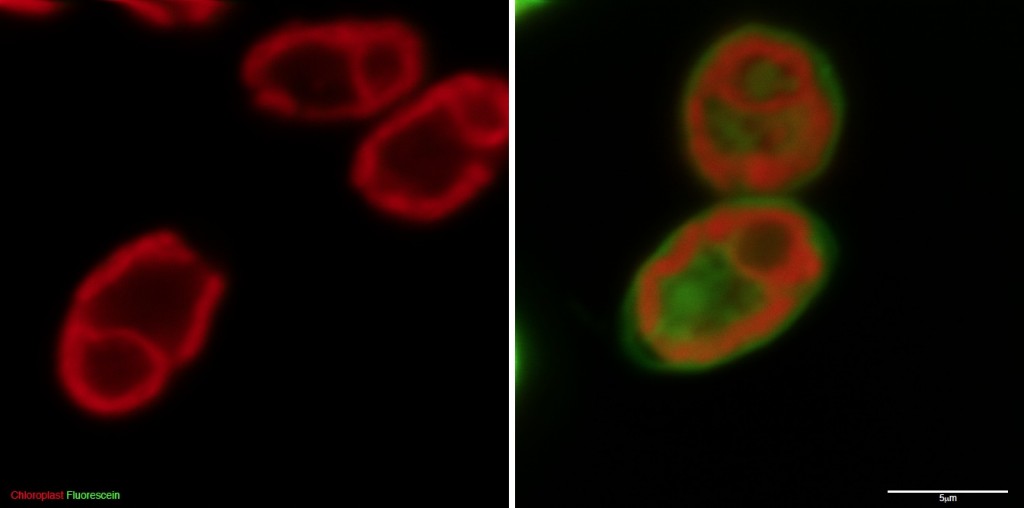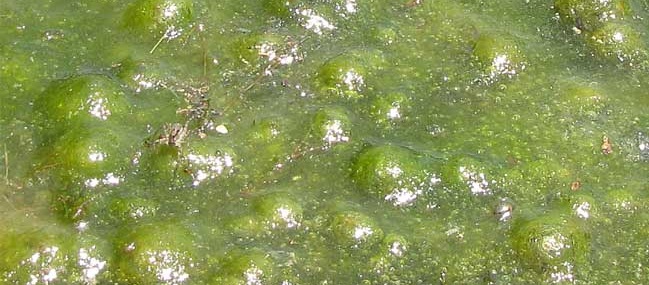That green muck you see on a pond’s surface is one step closer to becoming a solar-powered source of some of the stuff you use everyday. Scientists from the U.S. Department of Energy’s Lawrence Berkeley National Laboratory (Berkeley Lab) and Stanford University have developed a way to send molecules and proteins across the cell wall of algae, a feat that opens the door for a new way to study and manipulate these tiny organisms.
In recent years, algae have become a hot prospect as a way to synthesize biofuels, chemical building blocks, vaccines, pharmaceuticals, and other useful compounds. The idea is to engineer algae to secrete fuel for your car or other compounds using sunlight as an energy source and carbon dioxide as a carbon source.
But before scientists learn the best ways to harness the power of algae, they must first gain a better understanding of what happens inside algae cells. They must also learn how to optimize the inner-workings of algae for the production of biofuels and other applications.
This requires slipping molecular-sized cargo inside algae cells to track metabolic changes and the flux of carbon, or to tweak the cell’s energy-producing mechanisms. And this is where the going gets difficult. Algae cells are protected by a double defense—an outer wall and lipid membrane—that blocks unwanted molecules from getting inside.
Now, Berkeley Lab scientists have broken the algae barrier. They’ve shown that a specially developed molecular transporter can deliver small molecules, and larger molecules such as proteins, through the cell wall and membrane of certain species of algae.
“We show for the first time that a guanidinium-rich molecular transporter can deliver a variety of cargo in several algae species,” says Bahram Parvin, a staff scientist in Berkeley Lab’s Life Sciences Division. “The range of uses for this molecular transporter is likely to be very broad. It could offer insights on algae barriers and serve as a new tool for the molecular manipulation and imaging of algae.”
The research was led by Berkeley Lab’s Joel Hyman and Stanford University’s Erika Geihe and Brian Tantrow. Parvin and Stanford University’s Paul Wender are the co-corresponding authors of the research, which is described in a recent early edition of the Proceedings of the National Academy of Sciences.

Proof that it works. In the left microscopy image, obtained during a control experiment, a green fluorescent tracer called fluorescein is not delivered inside algae cells when the tracer is only mixed with the molecular transporter. In the right image, fluorescein is successfully delivered inside algae cells when it’s covalently linked to the molecular transporter. (Image courtesy of Parvin lab)
The scientists started with a molecular transporter (also known as a cell-penetrating peptide or protein transduction domain) that features arginine, one of the amino acids found in all proteins. Arginine is in the guanidinium family of organic compounds. For the past several years, Wender’s group has developed ways to deliver drugs and other small molecules into mammalian cells using guanidinium-rich molecular transporters. They and others have also laden transporters with cargo such as metals, imaging agents, and genetic material.
But little was known about the ability of this type of transporter to enter non-mammalian cells, especially those of organisms that possess a cell wall.
The Berkeley Lab and Stanford University scientists conducted several experiments that showed that guanidinium-rich molecular transporters can cross the cell wall of an algae species called Chlamydomonas reinhardtii, which was chosen because its molecular and genetic traits are well understood. In one experiment, they fastened a protein cargo to the transporter, and found that it too entered the cell. The scientists also showed that the transporter can enter the cells of other algae species including Neochloris oleoabundans and Scenedesmus dimorphus.
Until now, the main way researchers delivered molecules inside algae cells was to use physical processes, such as shooting tiny metal beads coated with DNA at cells. Another approach involves rapidly shaking cells with small glass beads coated with DNA or small molecules. This creates breaks in the cell wall and membrane, which allows the cargo to slip inside. In contrast, the Berkeley Lab technique doesn’t require such potentially damaging and inefficient methods.
The scientists next plan to refine the guanidinium-rich molecular transporter so that it can be used to optimize the energy-production pathways of algae. They’re modifying it so it can deliver genetic cargo, and they’re developing it into a sensitive assay for imaging gene expression. They’d also like to use it as a probe to track changes in algae’s carbon cycle as a result of genetic engineering.
“With algae, we’ve lacked the kind of effective tools for molecular and genetic engineering that we use in mammalian cells,” says Parvin. “That’s changing now. Our technology could enable scientists to manipulate algae’s energy-synthesis pathways and improve its ability to produce biofuels, among other applications.”
This research was supported in part by the Department of Energy’s Office of Science and the National Institutes of Health.
###
Lawrence Berkeley National Laboratory addresses the world’s most urgent scientific challenges by advancing sustainable energy, protecting human health, creating new materials, and revealing the origin and fate of the universe. Founded in 1931, Berkeley Lab’s scientific expertise has been recognized with 13 Nobel prizes. The University of California manages Berkeley Lab for the U.S. Department of Energy’s Office of Science. For more, visit www.lbl.gov.
DOE’s Office of Science is the single largest supporter of basic research in the physical sciences in the United States, and is working to address some of the most pressing challenges of our time. For more information, please visit science.energy.gov.
Additional information:
This research is described in a paper, “A molecular method for the delivery of small molecules and proteins across the cell wall of algae using molecular transporters,” which is published in a recent early edition of the Proceedings of National Academy of Science.
